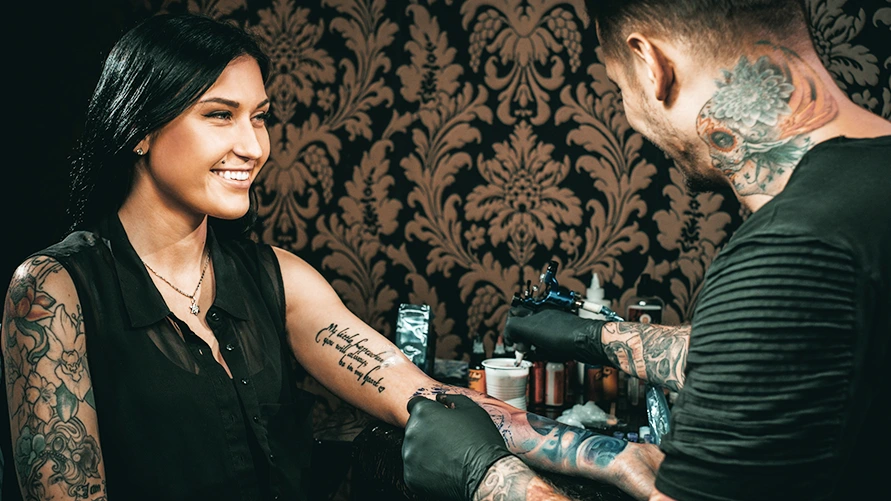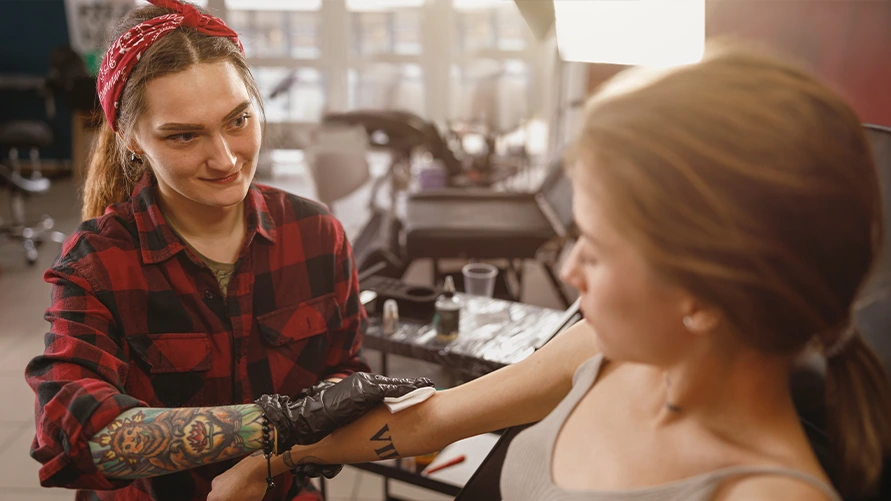How can tattoo owners fairly adjust the price of tattoos in the US? By setting rates that reflect skill, location, and design time, without undervaluing the art or scaring away clients.
Tattoo pricing is the heartbeat of every studio. Charge too little, and an artist’s hard work feels cheap, leaving little to cover rent, supplies, or growth. Charge too much, and clients walk out the door. The sweet spot is finding a fair price, one that respects the artist’s craft and keeps customers coming back.
Across the US, prices tell very different stories. A small tattoo in Los Angeles may cost $150, while the same ink in Ohio may start at $60. This gap proves that pricing isn’t one-size-fits-all; it’s a careful balance shaped by city costs, artist reputation, and even demand trends. Owners who master this balance create more than income; they build trust, sustainability, and long-term success for their studios.
Fair pricing isn’t just about numbers. It’s about respecting the art, the client, and the business. That’s why knowing how to set the right price is one of the most powerful skills a tattoo studio owner can have.

Why pricing is the heart of a tattoo studio
Every tattoo carries a story. But behind the story is a cost that keeps the lights on, pays for ink and sterilization, and rewards the hours you put in. Pricing matters because it is the business backbone of every studio.
In 2023, the U.S. tattoo industry earned over $1.4 billion. More people than ever are walking into studios, ready to get inked. With more competition, fair pricing is what separates the professional shops from the ones that don’t last. Clients notice when prices are consistent, clear, and professional. They also notice when things feel too cheap or unfair. Pricing is not only about profit. It’s also about showing that your studio values safety, skill, and artistry.
Tattoo pricing across the U.S. in 2025
Tattoo prices are not the same everywhere in the U.S. They depend on rent, cost of living, demand, and reputation. Knowing how pricing shifts by state helps owners set numbers that feel fair in their local market.
- In New York, small tattoos start around $150 to $200, while sleeves run $2,000 to $5,000. Big city studios charge more because of high demand and higher overhead.
- In California, hourly rates are some of the highest in the country, often $250 to $400 per hour for top artists. A medium forearm piece can cost between $600 and $1,200.
- In Texas, prices are more moderate. Small tattoos can be found for $80 to $120, and large sleeves range from $1,500 to $3,000.
- In Florida, the average hourly rate is $150 to $200, with medium tattoos often priced $300 to $600.
- In Ohio or Michigan, where the cost of living is lower, small tattoos often begin at $60 to $100, while larger designs may stay under $2,500.
These state differences show why tattoo owners must study local markets. A price that works in Los Angeles may be too high in Dallas, while a price in Dallas may undersell the same work in New York.

Small tattoos: Why the minimum fee matters
Small tattoos may take less time, but they still require setup, sterilization, and cleanup. That’s why most studios set a minimum fee, often between $80 and $150. In big cities like San Francisco, the minimum can reach $200.
Clients sometimes ask why a small butterfly or star costs so much. Owners explain that the cost covers not just ink but also gloves, sterilization, and professional tools. The minimum fee protects the studio from losing money on small jobs.
Medium tattoos: The balance between flat fees and hourly rates
Medium tattoos usually take 2 to 5 hours. These include forearm designs, chest pieces, or detailed symbols. In 2025, most U.S. studios charge $300 to $800; in big markets like Los Angeles or New York, that number can rise to $1,200.
For medium tattoos, many artists combine hourly and flat rates. They may set a flat base price and add extra if it runs long. What matters most is clarity. A client should walk in knowing what they’ll pay and why.
Large tattoos: Sessions keep it sustainable
Large tattoos are the soul of many studios; sleeves, back, or full legs. They can take 10 to 30+ hours, often spread across weeks or months. Prices range from $1,000 to $5,000 or more, depending on detail and the artist’s reputation.
Hourly rates work best for large pieces. In 2025, most U.S. artists charge $150 to $250 per hour, while artists with long waitlists can charge $300 to $400 per hour. Breaking the tattoo into sessions keeps things manageable. Clients can pay in parts, and artists don’t have to rush. It’s a win for both sides.
Custom designs: Pricing the art before the ink
Custom tattoos require more than tattooing. They begin with sketches, revisions, and client talks. This invisible work takes time. That’s why many studios now charge a design fee of $50 to $200, credited toward the final tattoo.
This fee sets boundaries. It ensures clients are serious and respect the creative effort. Without it, artists risk losing hours of work to indecision. Clients usually understand. They feel reassured that their design is truly unique and tailored to them.
Hourly rates: Still the standard
Hourly rates are simple, flexible, and still the most popular way to charge. Rates depend on skill, demand, and location. In smaller towns, beginners may charge $80 to $120 per hour. In mid-sized cities, experienced artists often set rates at $150 to $200 per hour; in the top U.S. markets like New York or Los Angeles, hourly rates range $250 to $400 per hour.
The hourly model protects both sides. If a tattoo takes longer than expected, the artist is still paid fairly. If it’s faster, the client pays less. The key is being upfront about what the hourly rate covers: supplies, breaks, and touch-ups.

Managing pricing with tattoo studio software
In 2025, running a tattoo shop means being both an artist and a business owner. That’s where tattoo shop software helps. It makes pricing, scheduling, and payments smooth and simple.
With software, studios can set minimum fees, create quotes, and collect deposits online. If a client books a sleeve, the system can break down costs by session and send automatic reminders. This keeps money matters clear and reduces last-minute cancellations. In fact, studies show that businesses using automated deposits see 30% fewer non-shows.
Tattoo studio software also helps manage supplies, track revenue, and organize client records. For owners, this means less stress over spreadsheets and more time for art. For clients, it means professionalism and trust. In a crowded industry, that trust is priceless.
The psychology of tattoo pricing
Pricing is not only math; it’s emotion. Clients see a price and decide if they feel safe and respected. Being too cheap can raise doubts about hygiene. Being too expensive without explanation can push them away.
Studies show 70% of clients are willing to pay more when they believe the service is high quality. For tattoo owners, this means being open about what the price includes: years of training, sterilized tools, and original design. When clients understand the value, they see the price as fair.
Mistakes tattoo owners must avoid
The biggest mistake is undervaluing your work. Many new studios undercharge to bring in clients, but this sets a trap. Once people expect low prices, it’s hard to raise them later.
Another mistake is inconsistency. If one client pays $400 for a half sleeve and another pays $600 for the same work, trust breaks. Consistent pricing builds credibility.
A final mistake is being vague. Clients should never leave confused about cost. A clear breakdown builds loyalty, even if the price is high.
Building loyalty through fair pricing
Fair pricing creates more than money. It creates relationships. Clients who feel respected will come back, bring friends, and post about you on social media. Research shows that over 90% of tattoo clients find their artist through referrals or social platforms.
When pricing is transparent, steady, and professional, it becomes part of your brand. Clients remember the experience of being treated with honesty, and that memory brings them back for more ink.
Final thoughts
The right way to charge for tattoos in 2025 is about balance. Small tattoos need a minimum fee. Medium tattoos need clear quotes. Large tattoos work best with session-based hourly rates. Custom tattoos must include design fees.
Use transparency to build trust. Use tattoo studio software to handle deposits, quotes, and schedules. Value your time and respect your clients. Tattoos are not just ink on skin; they are art, safety, and experience. When you charge the right way, clients don’t just pay for a tattoo. They pay for a story, a safe space, and an artist they can trust for life.